New, Vented Crawlspaces Should Be Illegal.
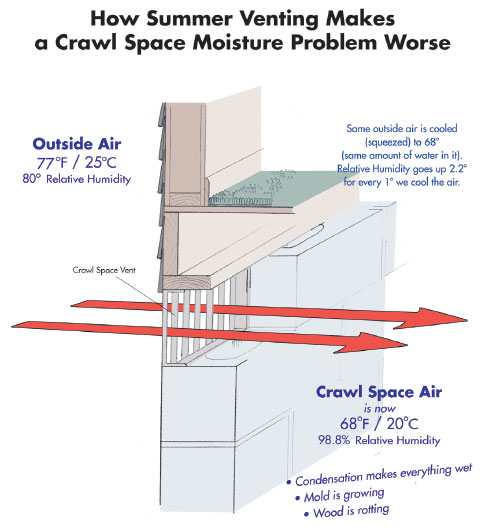
Its a harsh stance and tough defense, considering the entrenchment of this common, code-compliant construction detail. I am on board for most local and common practices done right, but its tough denying that most building science research is condemning the classic vented-crawlspace in our climate. Its time for this building practice to be outlawed for new construction.
Vented Crawlspace = Attached Cave
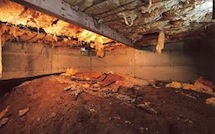 There are plenty of examples seemingly doing fine but dry crawlspaces can still have negative effects on the breathing spaces above. Most vented crawlspaces are not dry, they are building science disasters. Do you really think building a cave below your house is a good idea? Dangerous concerns come with sharing breathing space with the open earth.
There are plenty of examples seemingly doing fine but dry crawlspaces can still have negative effects on the breathing spaces above. Most vented crawlspaces are not dry, they are building science disasters. Do you really think building a cave below your house is a good idea? Dangerous concerns come with sharing breathing space with the open earth.
Radon continues its assent as one of the most alarming forms of indoor-air pollution. While radon is an issue for all foundations, homes on slabs (stemwalls or basements) offer more control over water and soil gases like radon.
Vented-crawlspaces don't make sense in humid-climates.
CrawlSpace.org Energy Vangaurd #1, #2, HomeEnergy: The scary crawlspace
Venting crawlspaces in humid climates increases moisture problems.
Unvented crawlspace. Better yet, no crawlspace.
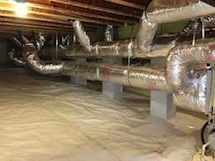 Even crawlspace enthusiasts agree, the only right way to build a crawlspace, is by building an unvented crawlspace.
Even crawlspace enthusiasts agree, the only right way to build a crawlspace, is by building an unvented crawlspace.
Unvented crawlspaces use plastic sheeting to seal out the ground from the crawlspace air which is easier said than done. This plastic needs to be completely sealed to the walls, piers and any other penetrations from the ground. In areas prone to groundwater during heavy rains, the crawlspace grade should be sloped to a day-light drain. Crawlspace walls should be insulated, while allowing some portion available for termite path inspection. Finally, unvented crawlspaces need some type of de-humidification or space conditioning which adds to energy costs and maintenance needs.
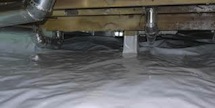 One of our arguments against crawlspaces is that cramped conditions leads to inferior work from all parties involved with the home. Carpenters, plumbers, electricians, HVAC contractors, crawlspace encapsulation workers, energy raters, the builder and finally the homeowner. Show of hands to go spelunking to ensure craftsmanship and maintenance?
One of our arguments against crawlspaces is that cramped conditions leads to inferior work from all parties involved with the home. Carpenters, plumbers, electricians, HVAC contractors, crawlspace encapsulation workers, energy raters, the builder and finally the homeowner. Show of hands to go spelunking to ensure craftsmanship and maintenance?
Consider a basement or stemwall-with-slab instead of an unvented crawlspace
Stemwalls-with-slabs work anywhere suited for a crawlspace. Its better building science thanks to a more defined building envelope. Nature and exhaust fans work hard to push and pull dangerous air through a home's bottom. We need the building envelope proven airtight to help control this phenomena.
Moisture and soil gases like radon are big risks to indoor-air quality. Building researchers seemingly agree it's easier to create a solid separation of the ground with a slab. This is largely due to the even bed of clean gravel and vapor barrier called for by good slab construction. Simple plumbing pipes can do double duty as sub-slab drainage and passive radon mitigation systems. The taller the stemwall and more volume of clean gravel, the better the protection. Unvented crawlspaces are not as well suited for low lying ground water drainage and sub-grade de-pressurization efforts.
There are plenty of good opinions against slabs. Basements seem better accepted, and 99% have slabs. Slabs are the US's most common foundation type.
More on slab instead of crawlspace
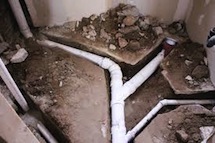
I find opinions against slabs mostly come from those uncomfortable with concrete work. The best argument: its hard to change plumbing. Plumbing supply comes from the meter or well underground in both cases. Changing or adding waste lines under slabs is most intensive, but usually not a problem as the house is likely undergoing major renovation anyway. Its still considered light construction and they rarely change much. Its just another day in the life of a professional who does this kind of thing for a living.
Joint and orthopedic concerns
We have yet to see any research lending validation. There are studies pointing to dog's toenail problems and such concerns should be applied to all hard surfaces including tile and hardwood. I disagree that wood or wood framed floors make much of a difference. Modern, code built floors have immeasurable deflection from normal foot traffic. The only finish I notice a difference is rug or carpet with thick padding which is among the worst material choices for those with indoor-air quality concerns. A better strategy for joint and related concerns are orthopedic insoles.
Cold floors
We include insulation under our slabs, making them close to the same temperature as the indoor-air. This also reduces chances of condensation and creates another redundant barrier to soil moisture and gases like radon.
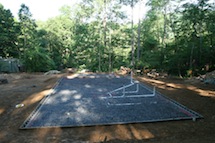 Flooding
Flooding
Problems, which are usually small plumbing leaks, are more quickly discovered with a slab. Subfloors and framing are more at risk of rot than concrete. Leaks getting past the slab, drain harmlessly through the gravel. Leaks past a subfloor pool or soak in the crawlspace, increasing humidity, energy costs and risks of mildew and mold.
Higher groundwater from heavy rain is easier avoided with raised gravel drained to daylight. Crawlspaces are usually tougher to get positive drainage around the house and daylight drains from under the house because of the sub-grade conditions.
Crawlspaces contribute to higher humidity, mold/mildew, and are tougher to remediate for radon and other soil gases making them a poor choice for those concerned with indoor-air quality. They also contribute to higher energy costs which is not good for outdoor-air quality.
If still not convinced, at least be sure your crawlspace is properly encapsulated and unvented, which goes for existing homes too. Eventually, vented crawlspaces will be an illegal building practice in new construction. This is why we will not include them directly below living spaces. We will do unvented crawlspaces, but had to write this blog on why we think there are usually better options. Here is another common building practice worth a look at.
 Combustion Appliances Inside
Combustion Appliances Inside .jpg) Dangers of Attached Garages
Dangers of Attached Garages
Springtime Builders is an Asheville NC custom home builder specializing in building science craftsmanship and indoor-air quality.
Posted in Building Envelope
